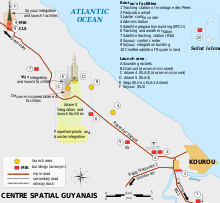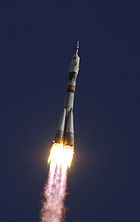Ensemble de Lancement Soyouz

 | |||||||||||||
| Launch site | Guiana Space Centre | ||||||||||||
|---|---|---|---|---|---|---|---|---|---|---|---|---|---|
| Short name | ELS | ||||||||||||
| Operator | Arianespace | ||||||||||||
| Launch pad(s) | One | ||||||||||||
| |||||||||||||

The Ensemble de Lancement Soyouz (ELS) (in English; Soyuz Launch Complex), is a launch complex at the Guiana Space Centre in Kourou/Sinnamary, French Guiana.[1] It is used by Soyuz-ST rockets: modified versions of the Soyuz-2 optimised for launch from Kourou.
The first launch to use the complex occurred on 21 October 2011, when a Soyuz ST-B launched the first two Galileo IOV-1 & IOV-2 spacecraft.[2]
The site's equatorial latitude allows a greater payload mass to be delivered into geosynchronous transfer orbit compared to existing Soyuz launch facilities at the Baikonur Cosmodrome in Kazakhstan.[2]
ELS is fifteen kilometres northwest of the launch facilities used by Ariane rockets.
It consists of a single launch pad, with a horizontal assembly and processing facility, or MIK, located 700 metres away. As with the Soyuz launch complexes at Baikonur and Plesetsk, the pad is connected to the MIK by means of a wide gauge railway, along which the rocket is transported before erection at the pad.
Unlike other Soyuz launch complexes, the pad features a mobile service tower, where the payload is integrated when the rocket is in the vertical position; at Baikonur and Plesetsk the payload is horizontally integrated in the MIK before the rocket is moved to the pad.[3] The tower shrouds the rocket during integration, but is moved back to a safe distance (again on rails) prior to launch.
ELS also differs in having a fixed launch mount, rather than one which can be rotated,[4] meaning that the rocket may need to execute a roll manoeuvre during its ascent to orbit. Earlier rockets in the R-7 family were incapable of rolling, so their launch complexes were built to allow launch azimuth to be adjusted before launch.
Launch history
| Flight | Date | Time (GMT) | Configuration | Result | Payload | Remarks |
|---|---|---|---|---|---|---|
| VS01 | 21 October 2011 | 10:30 | Soyuz 2.1b/ST Fregat | Success[5] | IOV-1 & IOV-2 | Navigation satellites |
| VS02 | 17 December 2011 | 02:03 | Soyuz 2.1a/ Fregat | Success[6] | Pleiades 1A SSOT ELISA (4 satellites) |
Imaging Satellite Earth observation satellite for Chile Electronic Intelligence Satellites |
| VS03 | 12 October 2012 | 18:15 | Soyuz 2.1b/ST Fregat | Success[7] | IOV-3 & IOV-4 | Navigation satellites |
| VS04 | 2 December 2012 | 02:02 | Soyuz 2.1a/ST Fregat | Success[8] | Pleiades 1B | Imaging Satellite |
| VS05 | 25 June 2013 | 19:27 | Soyuz 2.1b/ST Fregat | Success[9] | O3b 1/2/3/4 | Low Earth orbit communication satellites |
| VS06 | 19 December 2013 | 09:12 | Soyuz 2.1b/ST-B Fregat-MT | Success[10] | Gaia | Lissajous orbit - Space observatory |
| VS07 | 3 April 2014 | 21:02 | Soyuz 2.1b/ST-A Fregat-M | Success[11] | Sentinel-1A | Sun-synchronous orbit - Earth observation |
| VS08 | 10 July 2014 | Soyuz 2.1b/ST-B | Success[12] | O3b 5/6/7/8 | Low Earth orbit communication satellites | |
| VS09 | 2014 | Soyuz 2.1b/ST Fregat | FOC-1 & FOC-2 | Navigation satellites |
References
- ^ "Construction of Soyouz launch pad in French Guiana". Centre Spatial Guyanais. CNES. Retrieved 2009-03-18.
- ^ a b "Soyuz". European Space Agency. Retrieved 2011-01-24.
- ^ "Overview". Soyuz launch site. Arianespace. Retrieved 2009-03-18.
- ^ "Installation of the Soyuz launch system begins at Europe's Spaceport". Soyuz & Vega at the Spaceport. Arianespace. 2009-02-19. Retrieved 2009-03-18.
- ^ Soyuz flight VS01 Lifts Off From French Guiana.
- ^ Six defense satellites launched by Soyuz rocket
- ^ Soyuz ST-B launches Galileo twins successfully to orbit.
- ^ Arianespace Soyuz ST-A successfully launches Pleiades 1B
- ^ “The journey begins” with a lift from Arianespace: O3b Networks’ first four satellites are in orbit
- ^ Soyuz ST-B successfully launches Gaia space observatory
- ^ Graham, William; Bergin, Chris (2014-04-03). "Arianespace Soyuz ST-A launches Sentinel-1A mission". Retrieved 2014-04-06.
- ^ Arianespace (2014-07-10). "Arianespace launches O3b satellites on Soyuz mission". Retrieved 2014-07-12.
5°18′07″N 52°50′04″W / 5.301861°N 52.834582°W

